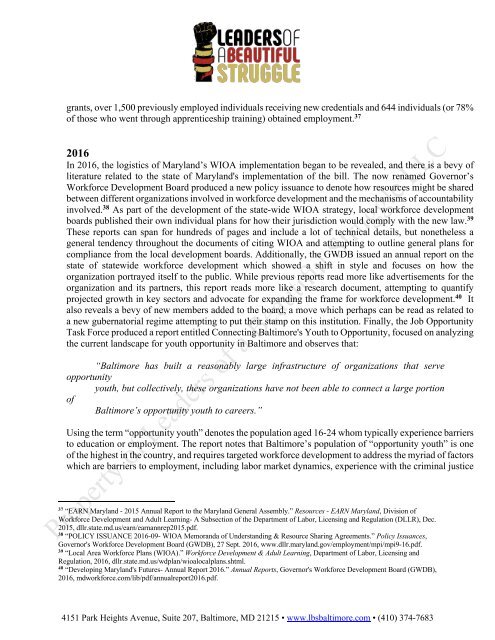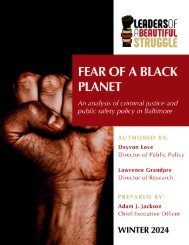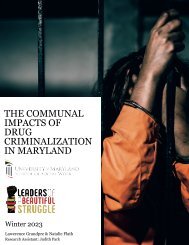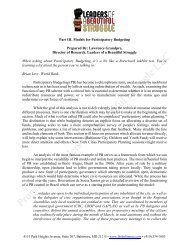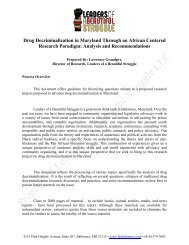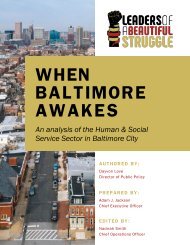Workforce Development Legislation and Practice Literature Review, Maryland, 2007-2017
This document attempts to create an overview of the literature around the legislative and political dynamics around workforce development theory and practice in Maryland through the years 2007 through 2017. This period includes three different gubernatorial regimes, three presidents, a massive shift in federal workforce development policy, and the largest economic contraction in the United States since the great recession. While the tumultuous circumstances this time period encompasses adds an additional layer of complexity to an already diverse state workforce environment, over time general trends can be observed and evaluated
This document attempts to create an overview of the literature around the legislative and political dynamics around workforce development theory and practice in Maryland through the years 2007 through 2017. This period includes three different gubernatorial regimes, three presidents, a massive shift in federal workforce development policy, and the largest economic contraction in the United States since the great recession. While the tumultuous circumstances this time period encompasses adds an additional layer of complexity to an already diverse state workforce environment, over time general trends can be observed and evaluated
Create successful ePaper yourself
Turn your PDF publications into a flip-book with our unique Google optimized e-Paper software.
grants, over 1,500 previously employed individuals receiving new credentials <strong>and</strong> 644 individuals (or 78%<br />
of those who went through apprenticeship training) obtained employment. 37<br />
2016<br />
In 2016, the logistics of Maryl<strong>and</strong>’s WIOA implementation began to be revealed, <strong>and</strong> there is a bevy of<br />
literature related to the state of Maryl<strong>and</strong>'s implementation of the bill. The now renamed Governor’s<br />
<strong>Workforce</strong> <strong>Development</strong> Board produced a new policy issuance to denote how resources might be shared<br />
between different organizations involved in workforce development <strong>and</strong> the mechanisms of accountability<br />
involved. 38 As part of the development of the state-wide WIOA strategy, local workforce development<br />
boards published their own individual plans for how their jurisdiction would comply with the new law. 39<br />
These reports can span for hundreds of pages <strong>and</strong> include a lot of technical details, but nonetheless a<br />
general tendency throughout the documents of citing WIOA <strong>and</strong> attempting to outline general plans for<br />
compliance from the local development boards. Additionally, the GWDB issued an annual report on the<br />
state of statewide workforce development which showed a shift in style <strong>and</strong> focuses on how the<br />
organization portrayed itself to the public. While previous reports read more like advertisements for the<br />
organization <strong>and</strong> its partners, this report reads more like a research document, attempting to quantify<br />
projected growth in key sectors <strong>and</strong> advocate for exp<strong>and</strong>ing the frame for workforce development. 40 It<br />
also reveals a bevy of new members added to the board, a move which perhaps can be read as related to<br />
a new gubernatorial regime attempting to put their stamp on this institution. Finally, the Job Opportunity<br />
Task Force produced a report entitled Connecting Baltimore's Youth to Opportunity, focused on analyzing<br />
the current l<strong>and</strong>scape for youth opportunity in Baltimore <strong>and</strong> observes that:<br />
“Baltimore has built a reasonably large infrastructure of organizations that serve<br />
opportunity<br />
youth, but collectively, these organizations have not been able to connect a large portion<br />
of<br />
Baltimore’s opportunity youth to careers.”<br />
Using the term “opportunity youth” denotes the population aged 16-24 whom typically experience barriers<br />
to education or employment. The report notes that Baltimore’s population of “opportunity youth” is one<br />
of the highest in the country, <strong>and</strong> requires targeted workforce development to address the myriad of factors<br />
which are barriers to employment, including labor market dynamics, experience with the criminal justice<br />
37<br />
“EARN Maryl<strong>and</strong> - 2015 Annual Report to the Maryl<strong>and</strong> General Assembly.” Resources - EARN Maryl<strong>and</strong>, Division of<br />
<strong>Workforce</strong> <strong>Development</strong> <strong>and</strong> Adult Learning- A Subsection of the Department of Labor, Licensing <strong>and</strong> Regulation (DLLR), Dec.<br />
2015, dllr.state.md.us/earn/earnannrep2015.pdf.<br />
38<br />
“POLICY ISSUANCE 2016-09- WIOA Memor<strong>and</strong>a of Underst<strong>and</strong>ing & Resource Sharing Agreements.” Policy Issuances,<br />
Governor's <strong>Workforce</strong> <strong>Development</strong> Board (GWDB), 27 Sept. 2016, www.dllr.maryl<strong>and</strong>.gov/employment/mpi/mpi9-16.pdf.<br />
39<br />
“Local Area <strong>Workforce</strong> Plans (WIOA).” <strong>Workforce</strong> <strong>Development</strong> & Adult Learning, Department of Labor, Licensing <strong>and</strong><br />
Regulation, 2016, dllr.state.md.us/wdplan/wioalocalplans.shtml.<br />
40<br />
“Developing Maryl<strong>and</strong>'s Futures- Annual Report 2016.” Annual Reports, Governor's <strong>Workforce</strong> <strong>Development</strong> Board (GWDB),<br />
2016, mdworkforce.com/lib/pdf/annualreport2016.pdf.<br />
4151 Park Heights Avenue, Suite 207, Baltimore, MD 21215 • www.lbsbaltimore.com • (410) 374-7683


